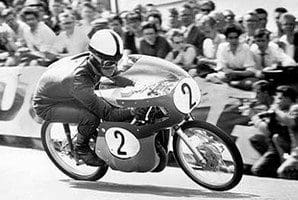
Suzuki 1952 – Japan
Born in Hamamatsu during 1887, Michio Suzuki founded his business in 1909 to manufacture silk weaving looms. Almost two decades later, Suzuki developed a basic four-cylinder car engine and in 1937 signed a contract to build Austin Seven cars under licence. Like many, Suzuki’s plans were sunk without trace by WWII.
War over, the business again made looms but with silk in short supply Suzuki had to look to other work or face bankruptcy. Engineering plus the manufacture of farm machinery and heaters kept the business viable.
By 1950 Michio realised the potential of personal transport, leading to the concept of a 36cc cyclemotor for attachment to almost any cycle. Development work began in autumn 1951 and in June 1952 the 36cc Power Free was marketed. Less than a year later in March 1953 Suzuki unveiled the 60cc Diamond Free.
Like Honda, Michio Suzuki had sized up the market’s needs perfectly. Developing a sound start, the 90cc four-stroke Colleda appeared in May 1954, then promptly won the Mount Fuji hill climb as the Diamond Free had earlier. Significantly, Suzuki took a long hard look at the best two-stroke design around, the DKW RT125 (didn’t everyone?), before developing the 125cc two-stroke Colleda ST.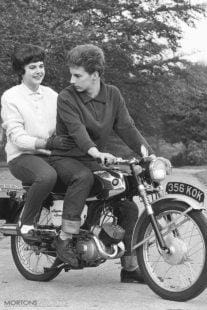
Just five years after the first Suzuki cyclemotors pop popped into life, Suzuki built a large new plant to cope with demand. Keen to expand, Michio’s son looked at the lucrative North American markets. Equally keen to promote their name, Suzuki built their first ‘works’ race model for the 1959 season, the 125cc Colleda RB, which proved useful but not yet ready to make an impact on the international scene.
Suzuki entered three machines in the 1960 125cc Lightweight TT under the Colleda brand rather than Suzuki. Although slow, all finished. A year later they entered under the Suzuki brand in the Lightweight 125 and 250 classes with a 10th their best place in the 250 race.
While racing appealed and could bring much kudos, commuter lightweights earned valuable income. Made in huge quantities, the K and M series two-stroke singles secured Suzuki financially. Not only were Suzuki two-stroke lightweights well built and durable, they were near idiot proof; no forgetting to add oil to the petrol, instead oil from a separate tank was metered into the engine by the Suzuki Controlled Crankshaft Injection (CCI) system.
Having raced MZs and worked alongside the world’s leading performance two-stroke engineer Walter Kaaden, Ernst Degner defected at the 1961 Swedish GP. Himself a clever racing engineer, the Silesian worked hard with Suzuki technicians during the winter of 1961/2 on an all-new 50cc two-stroke racer. To describe the results of Kaaden’s expertise skilfully applied by Degner and Suzuki as sensational is an understatement.
Using disc valve induction control and expansion chamber capacity measured precisely against port timing, the new 50 developed 10bhp@11,000rpm, enough for 90mph on a fully faired machine. Using the new racer, 30-year-old Ernst Degner gave Suzuki its first IoM TT and GP win in 1962 at a race speed of 75.12mph. Further wins at Assen, Spa and Solitude, along with places, gave Degner his first and only world title – and Suzuki their first of many. Degner was ably supported by Mitsuo Itoh, who became Suzuki’s racing manager.
Development, with strong involvement from Degner, led to the 125cc disc-valve twin which took New Zealander Hugh Anderson to the 1963 and 1965 125cc world titles. He also scooped the 1963 and 1965 50cc titles before former Kreidler works rider Hans Anscheidt completed a hat-trick for Suzuki 1966-68.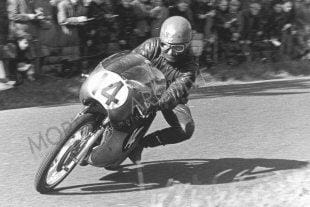
Against this continuing racing programme, the ever-ambitious Suzuki company began looking to larger machines while refining the ultra-lightweight models. One such example based on an earlier twin cylinder Colleda TT was the 246cc twin cylinder two-stroke T10, launched for 1963. With electric start and indicators, it was an advanced motorcycle.
While Suzuki had become a huge thorn in Honda’s side on the racing scene, the road models were anything but sporting until the mid-1960s. From its first 36cc Power Frees in 1952, Suzuki had developed a huge, successful business building pleasant, functional bulletproof roadsters aimed at the commuter and arguably tourers with the 250cc models. But in 1966 that all changed.
Named the T20 Super Six for much of the world including the UK and the X6 in the USA, the 29bhp, 90mph six-speed Super Six was something else. With weight trimmed – even the electric start was omitted – the 247cc two-stroke twin with 24mm carburettors and alloy barrels housed in a tubular frame set a new standard in the 250cc two-stroke class. For the first time riders of many larger machines watched the two-stroke haze disappear into the distance in front of them, rather than behind. And there wasn’t a thing they could do about it. And worse was yet to come!
As the Super Six, with its sophisticated Posi-Force oiling system, was an instant hit, Suzuki waited just a season before launching its first 100-plus-mph road going motorcycle, the two-stroke, twin cylinder, 110mph T500 Cobra (if you lived in America, tagged the T500 Titan.) The model was uprated over the coming seasons gaining disc brake, electronic ignition and the revised model code GT500. Production ended in 1977. Alongside the T500, the Hamamatsu factory unveiled the smaller, slower but again strong T200.
Officially Suzuki withdrew from road racing at the close of the 1967 season and contrary to some press reports implying all race machines were returned to Japan for crushing – they weren’t, or at least not all of them were. Two of the ex-works 125cc Suzukis found new homes with German Deiter Braun and Dutchman Cees Van Dongen. With Yamaha’s withdrawal after the 1968 team tactic incidents, Braun and Van Dongen finished second and third in the 125cc title chase behind Dave Simmonds’ Kawasaki. Still running as a privateer, Dieter scooped the 1970 title and Suzuki the constructor’s title.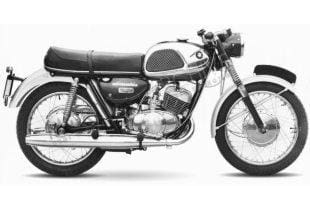
Having scored a second in 1970, a certain skinny Londoner, named Barry Sheene, riding a five-year-old ex-works machine fettled by dad Frank, won three GPs and took many places to gain second spot in the 1971 title chase behind Derbi’s Angelo Neito.
Against this background Suzuki was readying itself for an assault on the exclusive 500cc GP class and 750cc racing. Although there were later a few hiccups, 1971 went well with Australian Keith Turner and Dutchman Rob Bron finishing second and third in the 500cc riders’ title behind Giacomo Agostini’s MV Agusta. Neither Turner or Bron won a round, but gained many top places leaving Suzuki first blood to French based Australian Jack Findlay, who won the Ulster GP.
Despite by the late 1960s being the world’s largest by-volume maker of two-stroke motorcycles, Suzuki also manufactured outboard boat engines, boats, small vans, small cars, cycles and more. Against this background and with an eye on the lucrative North American market, Suzuki was also moving into the off-road world. As near unknowns in the scrambles scene, the Hamamatsu crew was given a valuable leg up in 1970 as former CZ works rider and world champion Belgian Joel Robert took the 1970 250cc crown for Suzuki. Robert repeated this for the following two years and Roger de Coster clinched five 500cc world titles between 1971 and 1976 missing out only 1974. If this wasn’t enough, tiny Belgian Gaston Rahier secured 125cc glory. Cashing in, Suzuki launched their first on/off dual purpose trail motorcycle in 1971, the two-stroke single cylinder TS125. This successful model was followed by a large family of TS models in the 50-400cc range. Although later the bigger models were dropped in favour of four-strokes, including the famed DR models, in updated form, TS variants served the Suzuki faithful for decades.
While the interest in off-road models took off, Suzuki also developed its roadsters. Air-cooled two-stroke triples joined the range, which were later updated with the famed Suzuki Ram Air cowling, designed to force cooling air through the barrels’ fins which in turn permitted the engines to be worked even harder. By the 1973 season Ram Air models included twin cylinder GT125, 185 and 250 plus the GT380 and 550 triples. The larger flagship water-cooled triple, the GT750, had been unveiled in 1971. Nicknamed the ‘kettle’ in the UK and ‘water buffalo’ in the USA, it was a super smooth motorcycle. During the 1970 TT, Dieter Braun on his way to winning the 125cc event – and the world title.
Going off at a tangent, Suzuki unveiled the rotary engined RE5 in 1974. Although slower and heavier than the GT750, it was an interesting concept which unfortunately didn’t sell in the quantities Suzuki hoped. Bristling with novel features and far more complex than the rotaries from DKW/Hercules and Norton, the RE5 received some bad press but today they are rare and sought after by both Suzuki and rotary engine collectors.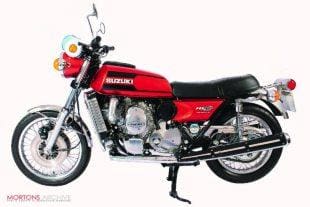
Against a reduced field, Jack Findlay won the 1973 Senior TT for Suzuki and two years later Barry Sheene scored wins in Holland and Sweden in the 500cc class. From a standing start Suzuki was poised for the big time – and took the crown in style in 1976. Sheene rocketed to his first world title and Suzuki machines filled 11 of the top 12 positions in the title chase, with only Giacomo Agostini’s MV Agusta spoiling a top dozen clean sweep.
Barry Sheene took the 1977 crown, then Kenny Robert’s Yamaha spoiled Suzuki’s stranglehold, but Suzuki took the constructors’ titles until Italian Marco Luchinelli secured the 1981 riders’ title for Suzuki. While all of this may not seem that significant in our terms, it’s worth remembering that in addition to the works machines, many GP runners were racing over-the-counter Suzuki four-cylinder, water-cooled, two-stroke RG500s.
Returning to road models, Suzuki began unveiling a succession of four-strokes, including in 1976 the transverse four-cylinder, dohc, 68bhp GS750. Suddenly, speed-wise Suzuki changed up a gear and with its stiffer rolling chassis – and given decent tyres – the GS750 went round corners quicker than many rival machines. A year later, the 997cc 135mph GS1000 appeared and for the touring rider the shaft drive GS850 was developed – later enlarged to the GS1000G in 1980 and the GS1100G in 1983.
Always known for their value-for-money, tough motorcycles, Suzuki launched the parallel twin cylinder GS400 with gear driven balance shaft to keep it smooth throughout its rev range. In 1979 it became the GS425, then the GS450 a year later and in 1989 the GS500.
Off-road trail models continued to be developed, including the four-stroke DR range – smaller versions were joined by the 44bhp DR600 in 1984 and the DR750 in 1987 which later led to the 780cc DR800. Still with an eye on the learner, lightweight and commuter markets, the ever faithful DR125 trail model – the ancestry of which can be traced back to the TS models – was regularly updated, and there was a range of small roadsters and the GN custom range.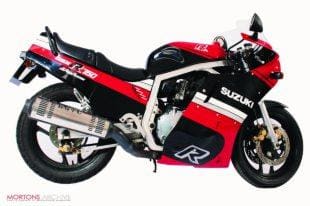
Four-stroke development took another leap forward with the launch of the first GSX models, including the 750 and 100bhp 1100, sporting Suzuki-developed Twin Swirl Combustion Chambers (TSCC) – in effect four valve, near-square-shaped combustion chambers designed to maximise fuel burn. A year later came the 250-1100cc 16-valve, four cylinder Katanas.
On the cusp of our self imposed 25 year rule came Suzuki’s first true over the counter clubman’s road racer which, like the earlier BSA Gold Star, sported full road equipment including lights. Following victory in the 1983 World Endurance Championships, Suzuki launched in autumn 1984 for the following season the DOHC 16-valve GSX-R750, initially offering 100bhp and 145mph – it was fast and handled superbly. With a range of factory parts on offer it was (and still is) easy to convert the GSX-R750 into a useful clubman’s racer which wouldn’t be left too far behind in national and international events – all of which must sound very familiar to Goldie fans.
Beyond our 25 year rule, Suzuki continued to build many tough durable models in all classes including a range of GSX-R models in 250-600cc capacities, the GSX600/750F sports tourers and in 1987 the 155mph GSX-R1100. Road/race models continued on offer including the RG250 and in 1990 the 125/135mph V-twin RGV250, which wasn’t too far removed from a works racer but with lights and road legal equipment.
Continuing the theme of top value tough models, the oil-cooled 125mph naked Bandit 600 appeared for 1995 – in effect an 80bhp, detuned GSX-R600 engine in a tubular steel frame; a superb motorcycle for minimal outlay which left rivals gasping. Later came a 1200 version. Seeing the appeal and success of Ducati V-twins Suzuki developed the SV650 and later the V-twin TL1000 which was unveiled for 1997, an R version which could/was and is developed for racing.
The Burgman twist and go fast scooters began with the 250cc version in 1998 and now the larger models exceed 100mph and while all this was going on, Suzuki were preparing to take the world by storm – again. And in 1999 the GSX1300R Hayabusa did just that, and with miles to spare! Claimed top speed was the double ton and – in racing crouch with bum raised to close the air pocket – light, leather-clad testers and racers have achieved the target. For the rest of us taller and/or chunkier lads/ladies 170-180mph is more a 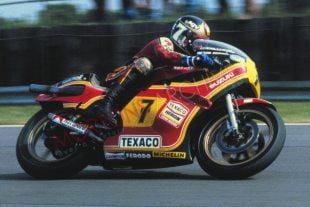 reality.
reality.
Enthusiasm for Suzuki is worldwide as it is for BSA, Triumph et al and with such a wide range of on and off-road models in all sizes along with over the counter racers, there’s something for every modern classic enthusiast.
Swallow 1955-c1962 Japan
Range of scooters for the Japanese market which began with the 30C T-165, a 165cc scooter with fully styled and enclosed bodywork equipped with indicators. On 10in wheels it was a luxury scooter. A year later the naked 80cc CP and fully enclosed 125cc CM were launched, both variants of the 10in wheeled Pop. In 1957 two-tone paintwork was on offer and a year later the 125cc model’s reworked engine gave more power. With identical styling the 175cc Pop appeared in 1958.
Never able to compete fully with the popular home market Fuji and Mitsubishi scooters production fizzled out in the early 1960s. A small number have filtered out of Japan onto both the European and American markets to be snapped up by avid scooter collectors.
Swallow 1947-51 UK
Founded in 1922 by William (later Sir) Lyons and William Walmsley in Blackpool to build sidecars, the business moved to Coventry in 1928. Car bodies, then cars including later the SS100, which was renamed the Jaguar, were developed alongside the sidecars. Relocated to Foleshill, Coventry as the Swallow Coachbuilding Company (1935) Ltd.
After WWII the business was sold to Helliwells of Glamorgan and production was moved to Walsall, where engineer Frank Rainbow designed the Swallow Gadabout scooter.
Full of character or plain ugly depending on your viewpoint, the Gadabout was launched in late 1946 powered by a Villiers 122cc 9D engine. On eight-inch wheels with no suspension at either end, it was offered with the option of a trade commercial sidecar for local tradesmen and delivery work. In 1950 the MkII model with 122cc Villiers 10D power and leading link front fork with rubber under torsion control was unveiled. A year later came a 197cc version with a Villiers 6E engine, designed for the tradesmen’s sidecar.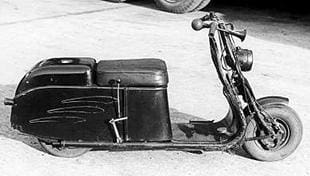
Unfortunately, Gadabout sales were slow compared with imported Vespa and Lambretta models, leading Swallow to drop the range in favour of sidecar manufacture including scooter sidecars.
Swift 1898-c1915 UK
Associated to Starley and Ariel, Swift – a company that had built cycles and sewing machines – began building De Dion Bouton and later also Aster engined tricycles and then cars. Motorcycle production is believed to have started with De Dion and possibly also Aster engined machines in small numbers. Also involved with Starley shaft drive motorcycle development. Later employed White & Poppe engines, with their distinctive wide gap between the inlet and exhaust valve. Swift also made a modest number of V-twins with their own engines.
SWM 1971-85 (1987) Italy
Pietro Sironi founded SWM at Rivolta D’Adda near Milan to build the best off-road motorcycles he could. Pietro succeeded and it was this success that brought about SWM’s downfall.
Many claim, some in humour or hindsight, that SWM is an abbreviation for ‘Speedy Working Motors’ and considering their performance and the growth of production it’s apt but not a motto Sironi initially coined. Production began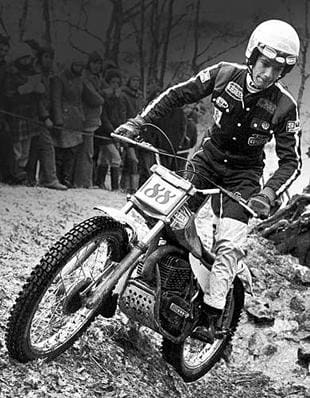 with a Sachs-engined 125cc six-speed enduro model, the Regolarita, and within a year the range had expanded to nine models including motocross machines in 50, 100 and 125cc capacities – all with German Sachs engines. During the 1972 season, SWM won the Italian 125cc motocross championship – successes that included ISDT golds.
with a Sachs-engined 125cc six-speed enduro model, the Regolarita, and within a year the range had expanded to nine models including motocross machines in 50, 100 and 125cc capacities – all with German Sachs engines. During the 1972 season, SWM won the Italian 125cc motocross championship – successes that included ISDT golds.
Rapidly the range was further expanded and revised with new frames plus Marzocchi shock absorbers and front forks. Further factory involvement including sporting support and export drives followed.
For 1975 mopeds and a selection of 175cc off-road models joined the range and by 1976 Austrian Rotax engines were used alongside the Sachs units. In 1977, renowned trials star Sammy Miller joined SWM to develop a selection of trials motorcycles.
By 1978 SWM offered a range of almost 30 off-road motorcycles and a couple of mopeds. This selection included larger models like the 247cc Rotax two-stroke engined motocross RS250MC. Riding on their great success, Pietro bought rivals Gori who also built a range of predominantly 50-250cc motocross machines, to expand his manufacturing capacity.
But by 1981/82 sales of his motorcycles were sliding due to recession and Sironi’s business struggled. With a large factory and manufacturing capacity SWM struggled and finally closed in 1985. Rapidly, Pietro Sironi reduced and restructured his business under the brand SVM, but this folded two years later.
With a rising interest in twin shock trials and motocross machines there is an increasing interest in SWM off-road motorcycles, helped by a reasonable spares back up for Sachs and Rotax engines. With Marzocchi forks/shock absorbers and Sironi’s strong, light, superb handling frames, they are a competitive choice in today’s classic events.
Syphax c1952-54 France
Maker from Nantes which built a range of 98-175cc lightweights, using AMC and Aubier-Dunne two-stroke engines and AMC 125-175cc ohv units. Examples occasionally surface in France and Belgium.


